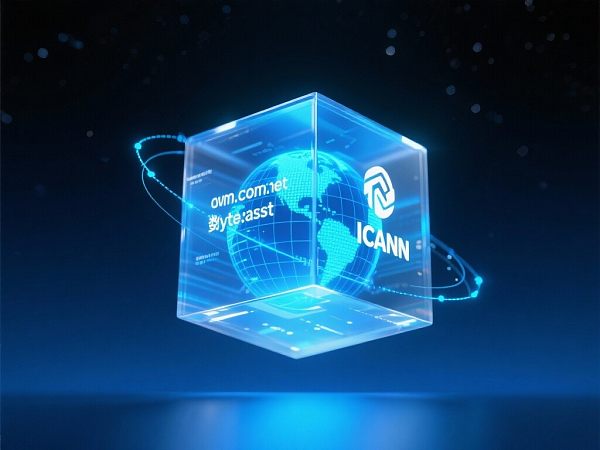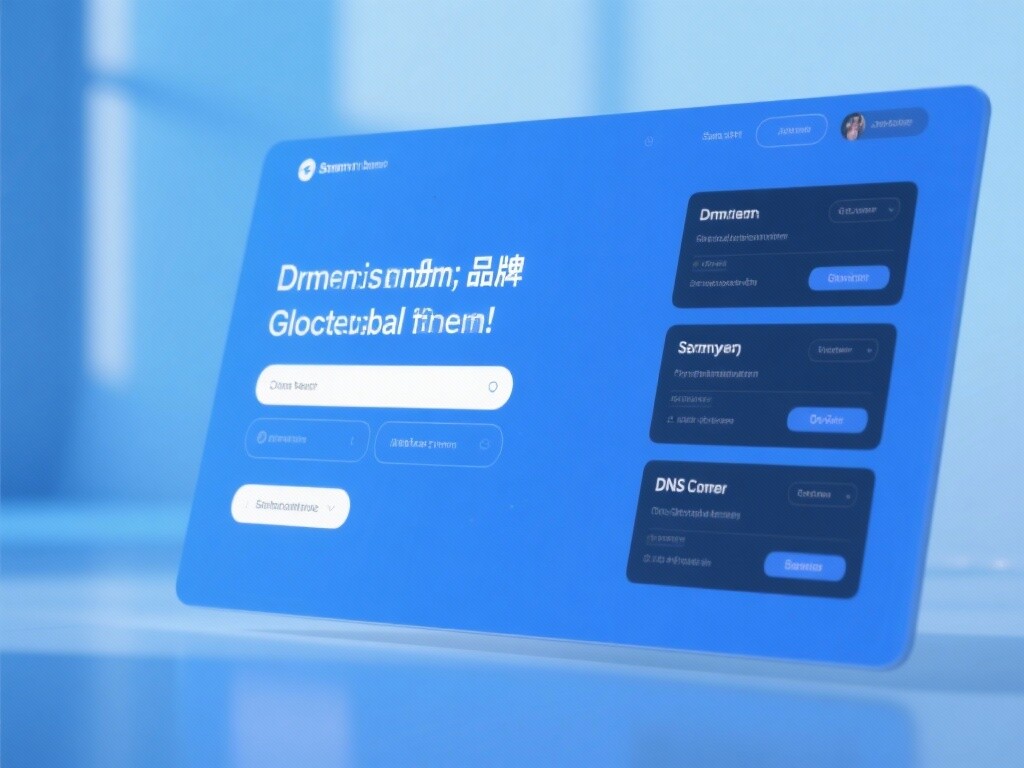Easy Camp Cloud Intelligent Website Construction and Marketing System Platform!
Definition of Domain Registration: The Digital World's Identity Proof
A domain name (Domain Name) is the unique identifier on the internet used to locate and identify computers or services (such as websites, email). Domain registration refers to the process where individuals or organizations apply for and obtain the right to use a specific domain for a certain period through a domain registrar, directed to a specific **domain registry organization (Registry)**.

Why Are Domains So Important?
Branding: A concise, memorable, and highly brand-relevant domain is the core of online brand communication.
Accessibility: Domains are user-friendly substitutes for IP addresses (like
192.168.1.1), allowing users to access websites by typing easy-to-remember names.Digital Asset: Premium domains hold high commercial and investment value, serving as crucial intangible digital assets for businesses.
SEO Foundation: Factors like domain structure, keyword relevance, and domain age are fundamental elements for search engine rankings (SEO).
Three Core Roles in Domain Registration
User/Registrant: The owner and user of the domain.
Registrar: An ICANN-accredited organization (e.g., Yiyingbao) that provides domain registration services directly to the public.
Registry: Manages the database and operations of top-level domains (TLDs), such as Verisign managing
.comand.net.
History of the Domain Name System: From IP Addresses to Global Naming
The evolution of the Domain Name System is a history of the internet transforming from a military research network into a global commercial and informational infrastructure:
1. Early Addressing (1960s-1980s): Hosts.txt and IP Addresses
In the early internet, each computer had only a numeric IP address. To aid memory, a Hosts.txt file mapped hostnames to IP addresses. As networks grew, manual maintenance became unsustainable.
2. Birth of DNS (1983-1985):
In 1983, Paul Mockapetris invented the Domain Name System (DNS), a hierarchical, distributed naming system automating domain-to-IP conversion. In 1985, the first generic top-level domains (gTLDs) like .com, .org, and .edu were registered, marking the dawn of modern domain registration.
3. Commercialization and Standardization (1990s): ICANN's Formation
With the WWW's rise, domain demand exploded. In 1998, ICANN (Internet Corporation for Assigned Names and Numbers) was established as a nonprofit to manage global internet resources, including domains and IPs, ending direct government control and creating a three-tier system of Registry-Registrar-Registrant.
4. TLD Expansion (2012-Present):
Addressing resource scarcity, ICANN launched the **New gTLD Program** in 2012, introducing thousands of suffixes like .shop, .tech, .xyz, and .app, enriching branding opportunities.
Technical Principles of Domain Registration: How DNS Works
Understanding domain registration requires mastering the underlying technology—DNS, a distributed database storing global domain-to-IP mappings in a hierarchical system.

1. Four Core Elements of DNS Resolution
When a user enters a domain (e.g., www.yiyingbao.com), DNS resolution involves four servers:
Recursive Resolver: The user's first query point (typically ISP or public DNS servers).
Root Name Server: The top-level DNS hierarchy directing resolvers to TLD servers.
TLD Name Server: Resolves specific suffixes (e.g.,
.com).Authoritative Name Server: Stores the final domain records (e.g.,
yiyingbao.com) and returns the IP.
2. DNS Resolution Process
Query Initiation: User enters a domain.
Recursive Query: The resolver checks its cache; if no record, queries the root server.
Hierarchical Resolution: The root directs to the TLD server, which then points to the authoritative server.
IP Retrieval: The authoritative server returns the IP to the resolver.
User Response: The resolver gives the IP to the browser, which connects to load the site.
This millisecond-fast process relies on efficient caching and a global server network.
Technical Features and Strategic Applications of Domain Registration
Modern domain services integrate security, performance, and marketing:
1. DNS Record Configuration
Post-registration, users configure DNS records via registrars:
A Record (Address): Maps a domain to an IPv4 address (most common).
CNAME (Canonical Name): Alias one subdomain to another (e.g.,
blog.example.comto a blog platform).MX Record (Mail Exchange): Specifies mail servers for domain emails.
TXT Record (Text): Stores text info, often for email authentication (SPF/DKIM) or site ownership verification (e.g., Google Search Console).
2. Domain Security Technologies
Domain Lock: Prevents unauthorized transfers.
Whois Privacy: Hides registrant details (name, address, phone) from spam and leaks.
DNSSEC (Domain Name System Security Extensions): Ensures DNS responses are authentic, thwarting DNS hijacking.
3. SEO Strategies for Domains
Domain choices directly impact SEO:
Brand Priority: Choose domains aligned with your brand for better searchability and trust.
Short & Memorable: Reduces typos and boosts direct traffic.
TLD Selection: .com remains the global standard; country-code TLDs (e.g.,
.cn,.tw) enhance local relevance.Brand Protection: Register key TLDs and common misspellings to prevent competitor hijacking.
Applications of Domain Registration: Building a Global Digital Ecosystem
Domain registration is the starting point for all digital ecosystems, with critical applications:
Yiyingbao: Your Domain Registration and Management Expert
Yiyingbao is not just an ICANN-accredited registrar but your digital asset strategist. We offer one-stop, secure, and efficient domain services:

Global Domain Registration: Covering mainstream TLDs (
.com,.net,.org) and thousands of new gTLDs and ccTLDs.High-Performance DNS: Globally distributed, highly available DNS ensures fast and stable site access.
End-to-End Security: Default Whois privacy and domain lock maximize security.
SEO Optimization: Our experts provide domain selection and configuration advice tailored to your industry and market.
User-Friendly Tools: Intuitive control panels for easy DNS management, renewals, and transfers.
Choosing Yiyingbao means choosing secure, reliable, and efficient protection for your digital assets.
FAQ
1. Can my website be accessed immediately after domain registration?
No. Successful domain registration only grants the right to use the name. You still need to complete the following steps:
Set up DNS resolution: Point your domain (via A record) to the IP address of your web hosting server.
Wait for resolution to take effect: Domain resolution requires time to propagate globally (typically a few minutes to 48 hours, known as TTL time).
Upload website files: Your hosting server must have actual website files to be accessible.
2. What is Whois privacy protection? Does it affect SEO?
Whois privacy protection is a service that allows registrars to replace your personal contact information (name, email, phone, etc.) with their proxy details in the public Whois database, protecting your privacy and preventing spam or fraud.It has no negative impact on SEO. Modern search engine ranking algorithms are not affected by whether Whois information is public. It is recommended that all users enable privacy protection.
3. How long is a domain registration period? What happens after expiration?
Domain registration periods typically range from 1 to 10 years. Once registered, you gain exclusive usage rights for that period.If a domain expires without renewal, it enters a grace period, redemption period, and is eventually released to the public market for re-registration. If your domain enters the redemption period, renewal costs become very high. Therefore,it is advisable to set up auto-renewal or register for multiple years upfront to protect your brand assets.
4. Should I choose a country-code domain (e.g., .cn) or a generic domain (e.g., .com)?
The choice depends on your target market:
Global focus: .com remains the most authoritative and trusted option worldwide.
Specific country/region focus: If your business targets a single country (e.g., China, Germany), choosing the corresponding**country-code top-level domain (ccTLD)**helps improve local user trust and search engine relevance in that country.

Customer Reviews
Mr. Zhang, Founder of a Cross-border E-commerce Platform
"After registering a domain with YiYingBao and using their DNS services, we clearly noticed faster global website access speeds. Their domain security lock and Whois privacy protection gave us great peace of mind. Most importantly, their experts helped us select several high-value New gTLD extensions, which successfully became brand domains for our new product line,significantly enhancing the professionalism of our new business. This was an extremely strategic partnership."
Ms. Wang, CTO of a Digital Marketing Agency
"As a technology-driven marketing company, we have extremely high requirements for DNS resolution speed and stability. YiYingBao'shigh-performance DNS resolutionservice ensures our clients' websites achievemillisecond-level response times, which is a huge advantage for search engine crawl frequency and user experience. Their technical support responds quickly, and their domain management interface is clear—they are a trustworthy domain registration and management partner."





